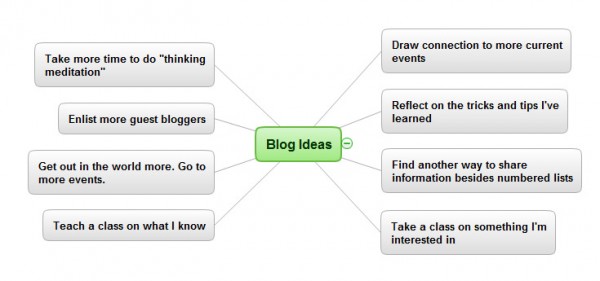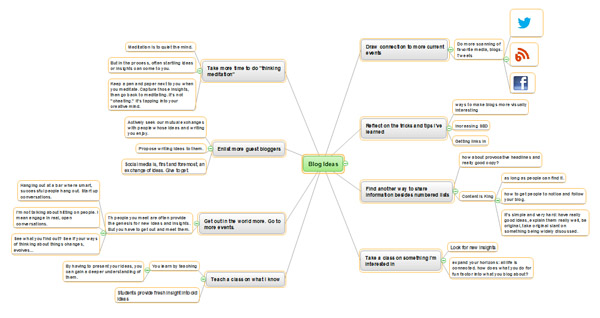As the saying goes, a journey of a thousand miles begins with a single step. But that first step can be a bear. Let’s say you need to come up with ideas for you blog posts. What’s the most interesting thing you can write about? Suppose a prospective client suddenly invites you in to help solve a vexing problem. What’s the first question you’ll ask? What if you want to launch a new product? What’s the first thing you need to do?
No matter what the creative activity is, the pressure to put aside all of the hundred other thoughts that spring to mind and figure out what is the single most important thing to do first… that can be overwhelming. It can make an otherwise creative mind come to a grinding halt. Because it’s not the way most people’s minds work.
You Mean That Everything I Learned about Planning is Wrong?
You may have been taught in elementary school or in business school to create plans by using nice, crisp outlines. But, in fact, trying to capture your thoughts in a linear outline is a little like trying to dance with your feet tied together. Yes, you can sort of shuffle along. But it’s painfully slow—and not very fun.
That’s because the human mind tends to think through association. We have one thought, which leads to another thought, and another thought, and so on. You are perfectly capable of coming up with a great question, a great plan, a great blog topic. But often, you have to kind of sneak up on it. Thinking creatively is a pretty fantastic process. And when the conditions are right, it can happen at lightning speed.
Working at the “Speed of Thought”
When you’re at the front end of a process—just about any process, your best thinking comes when you unshackle your mind, spread your nets wide, and quickly capture all the thoughts you can. Unfortunately, most business tools are so rigid, so linear, that they actually get in the way of this kind of good thinking.
Enter the wonderful, if largely unknown, world of mind mapping.
Now what, you might ask, is a mind map? Don’t worry. No high-tech brain scans or costly psychoanalysis involved. A mind map is simply a way to capture thoughts, insights, and information without making the usual top-down list. It is an uncommonly simple skill to learn. And it can have an immediate impact on your ability to think clearly and quickly, to plan quickly, to find creative solutions to stubborn problems. Let me give you a quick example of how you might put a mind map to work:
Can You Have Too Many Creative Thoughts?
Let’s say you want to come up with some new ideas about what to write on your blog. Instead of trying to make some neat list of ideas, just start capturing them as they come to you. The mind map software will spread them out evenly across the screen, like this:
It can be incredibly freeing to just capture ideas without worrying about what order they’re in—or even if they make a lot of sense at this point. The idea is to generate a lot of ideas first.
For people used to making outlines, working in the mind mapping interface can be a liberating experience. Curiously, the problem (if it is one) can be in limiting the number of ideas you have. In fact, many mind mapping applications have timers built into them so you can put a limit on just how much creative thinking you allow yourself to do.
Is that concept at all alien to you—having so many ideas that you need to find a way to limit them? Mind mapping put this kind of rapid creativity easily within your grasp.
Divergent to Convergent Thinking
Brainstorming can be invigorating and rewarding as you watch the ideas come pouring forth. Once you’ve given yourself a chance to think freely, it’s time to add some structure to your thinking. Mind maps accelerate this process by enabling you to simply drag and drop your ideas into an order that makes sense to you. In the process, you’ll probably find ideas that don’t work. Simply delete them. More often, you’ll notice that new ideas spring to mind; ideas that deepen or sharpen your thinking, that take your thinking into entirely new directions.
As you continue working on the map, your ideas can build on each other to give you some very concrete things to do. And the weird thing is that it all this thinking and planning can seem unusually, well… fun.
See the Big Picture. Dive to Details
Another problem with normal outlines is that they have a bad habit running off the page. And when you can’t see all of your thinking at once, problems can arise. It’s harder to see if you’ve covered all your bases or have left anything out. It also means that you may miss a connection between two ideas that leads to a critical new idea.
Probably one of the most ingenious things about mind map software is the way it automatically resizes content so that all work stays before you on one screen. Even if the map gets quite large, as it can easily do, it stays on one page.
Probably the second most ingenious things about mind maps is that they allow you to “collapse” parts of the map, to hide them from view so they don’t take up screen space. This allows you to focus in on one part of the map at a time—adding detail and depth to the map by capturing new thought, and by inserting links to web pages, documents, spread sheets, mages, sound, video… anything you can get to electronically. And when you are finished, you can collapse that part of the map and move on to the next part.
The end result is a document can, on one level, appear very simple—just a few thoughts on a page. But when you want to delve into any one thought, the document suddenly opens up to give you immediate access to tremendous amounts of information.
Share Your Ideas as Others Prefer to See Them
User research has shown that mind maps don’t appeal to everyone. Some people simply like lists. The better mind mapping applications solve this issue by enabling you to “view the map as an outline.” A simple click of a button allows you to view—and share—the mind map as a standard outline, export it to a slide program. You can do your creative thinking and planning in the mind map, then share it with others in whatever format they prefer.
Mind Mapping: Your New “Secret Weapon”?
While still relatively new to American business professionals, mind mapping applications have found their way inside an estimated 85 of the Fortune 100 companies. Here, they are used for strategic planning, for project management, for large writing and marketing projects and for countless other personal uses. In fact, some business users consider mind mapping so strategically important to their success that they consider mind mapping as their “secret weapon” and create them far from prying eyes in the privacy of their own offices.
One business user tells the story of suddenly being called on to lead a discussion on a global sales initiative. First he panicked: There was so much to say and so little time to prepare to say it. Then he calmed down and opened up a mind map. He started capturing his thoughts and insights about the initiative, linked to relevant documents and spread sheets, and mapped his way to a coherent presentation. A scant ten minutes later he felt confident to stand in front of the group and give a well-reasoned, thorough presentation. Try doing that with your normal business tools.
The next time you face writer’s block, need to do some creative thinking about a marketing campaign, or have been called on to give a presentation later that day, give mind mapping a try. You might be stunned by how quickly and creatively you can think. Mind mapping can, indeed, help you work at the speed of thought.
Do you use mind mapping to help you organize your thoughts? If not, would you consider using it now? Let us know by leaving a comment below!
___________________________________________________________________
Thank you to my Guest Post Author: Hobart Swan
Hobart has produced hundreds of radio programs for CBS Radio, developed a multi-part series for Japanese Public Television, written OpEds for the Los Angeles Times, and written just about every kind of business document you can name. He recommends ConceptDraw MINDMAP. Connect with him on Twitter, LinkedIn, and Facebook.
___________________________________________________________________




CommentLuv vs Disqus – Why I Don’t Use CommentLuv!